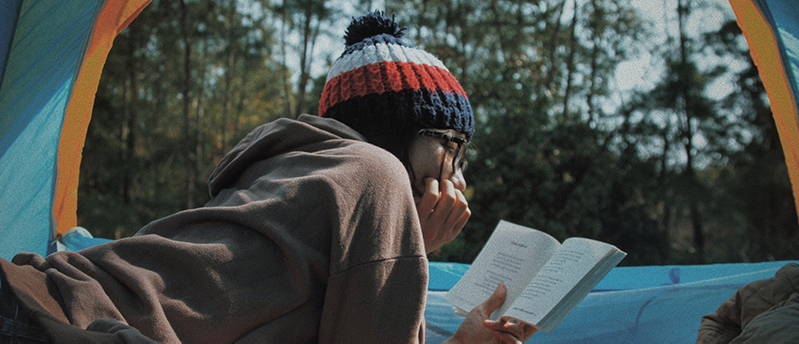
Literature often inspires nature activities, and it’s fun to carry literary themes into the outdoors. My Side of the Mountain by Jean Craighead George tells an amazing story of a boy who decides to live in the wild, and he finds a hollowed-out tree to make his home.
Older readers may be intrigued by Call of the Wild by Jack London or Hatchet by Gary Paulsen, both of which describe in great detail survival skills. Such literary prompts can lead to grand outdoor adventures and the development of important practical skills, including fire building, archery, woodcraft, camping, orienteering (using map and compass), tracking, wildlife identification, and other winter survival techniques.
Grab your compass, chart a course, and head out on an outdoor adventure of a literary kind!

Building a Debris Hut
One great survival skill that’s fun to practice anytime is building a temporary shelter out of leaves and sticks, often called a debris hut. These shelters are easy and quick to build and are surprisingly snug and warm.
The most basic debris hut consists of piling leaves and pine needles into a pile three feet high and longer than your height. Cover the top with branches. Burrow into the mound feet first (or head first, and then turn around so your head faces outward). The forest debris will provide a layer of insulation that traps your body heat and keeps you warm.
Using a fallen tree or branches for a frame
You and your child can build a more sturdy temporary shelter by using a fallen tree as a supporting framework. Prop branches onto the tree trunk in a tent shape, and then cover the branches with pieces of bark or more branches. Pile leaves on top of the branches, and inside the hut to provide a layer on top of the ground. Depending on how big your shelter is, you might be able to invite several friends inside for a snack and a story.
Using a rock as a shelter support

If you have a large rock or boulder nearby, you can use it as the “back wall” of your shelter, propping long sticks or branches against it in a teepee formation.Cover this structure with branches and leaves, and pad the floor with more leaves and pine needles. If you build your shelter against a rock, it will not only provide a sturdy backbone, but if you build a fire in front of your shelter, the rock will absorb and reflect back the heat.
Using a Compass
One of the foundational survival skills in both literature and daily life is the ability to find your way. Hone your child’s navigational skills with this simple activity. Using a compass, help your child orient to the cardinal directions: north, south, east, and west. Ask your child to show you which way your house or apartment faces. Which is the south side of the house? Which is the west side? Go outside, and have your child determine north, south, east, and west. Ask your child to identify something that lies in each of these directions.
Next, walk a little away from the house, and cover your child’s eyes. Spin them around, enough to get a little disoriented. Then ask your child to open their eyes and find the four directions without the compass. Check to see if they were correct by using the compass.
Keep in mind that children’s innate sense of direction varies greatly. Some children will pick up navigation exercises quickly, while others may struggle to orient themselves. Getting outside and practicing with a compass will help develop and strengthen these critical survival skills.
Navigating by the Stars

Exploring by night? Look to the stars! Grab two rulers and a protractor, and go outside tonight. Try to find the North Star (refer to a good astronomy book and a compass to help you, if necessary). Then, look for the horizon at its lowest point. Hold a ruler straight away from your face towards the horizon, sighting your eye along the length of the ruler to make sure you have it right. Hold one end of a second ruler against the end of the horizon ruler (your two hands will touch as you hold the two ends of the rules closest to you together). Point the second ruler at the North Star, while keeping the ends of the rulers touching.
Then, have someone hold the protractor with its straight edge along the straight edge of the ruler pointing at the horizon. Have that person look at the protractor and see which number of degree is at the bottom edge of the ruler pointing to the North Star. If you are somewhere in the Northern Hemisphere, this number will show your latitude.
Check your findings with a globe or world atlas. How accurate were you?
These outdoor activities offer students a true interdisciplinary learning experience from getting inspired by favorite literary works to using math and science to hone their survival skills. Learning is an adventure, and there’s so much out there just waiting to be discovered!